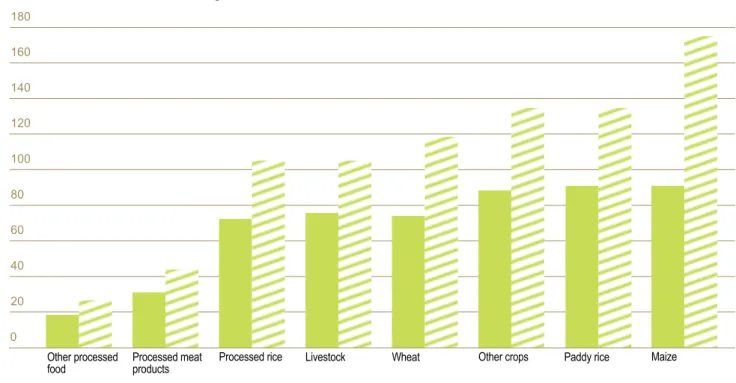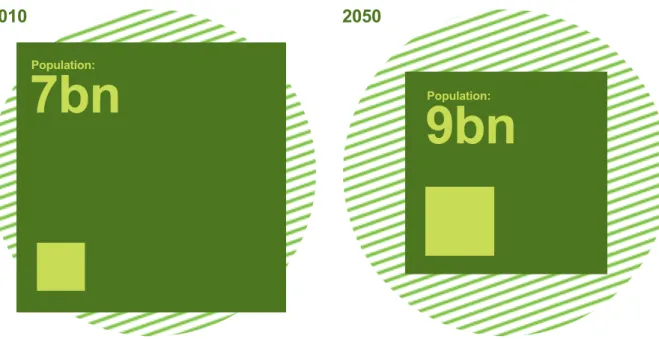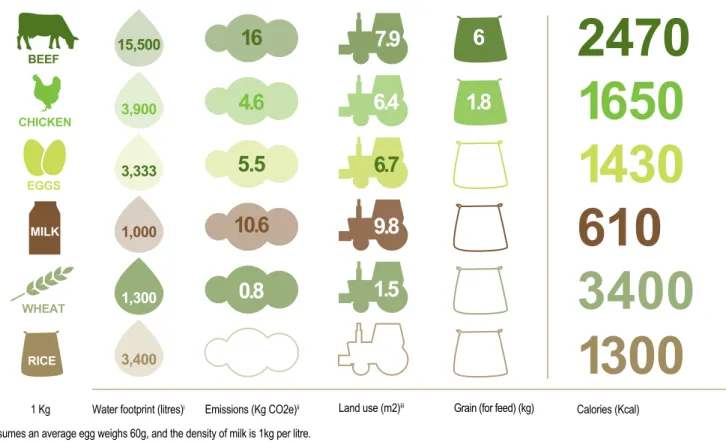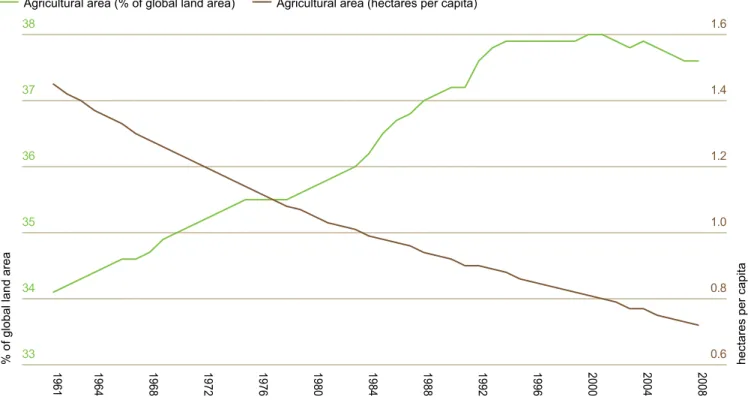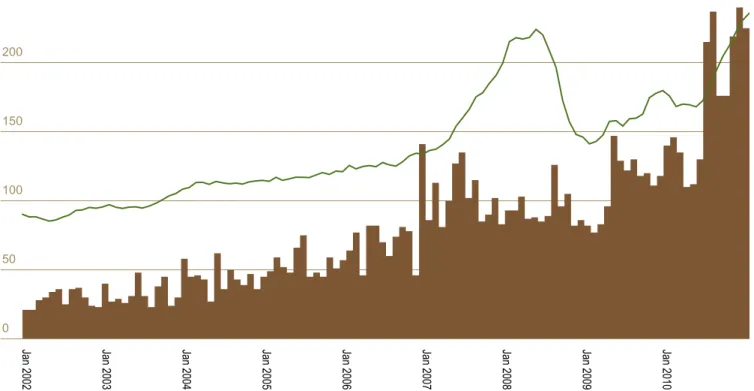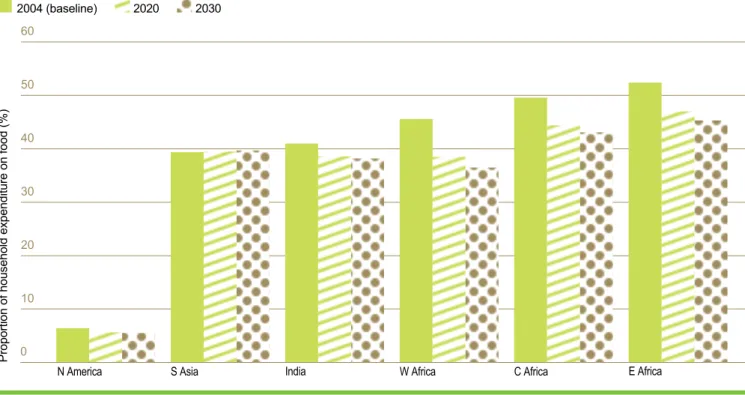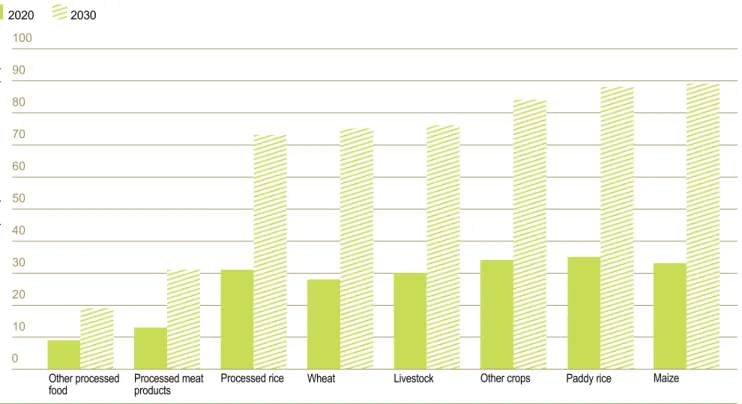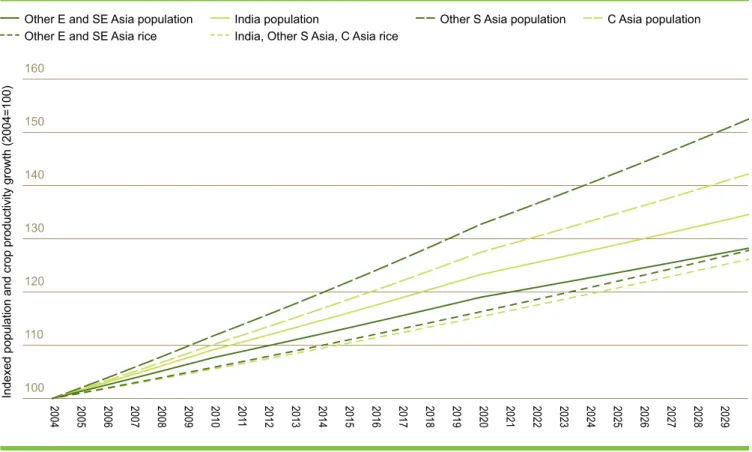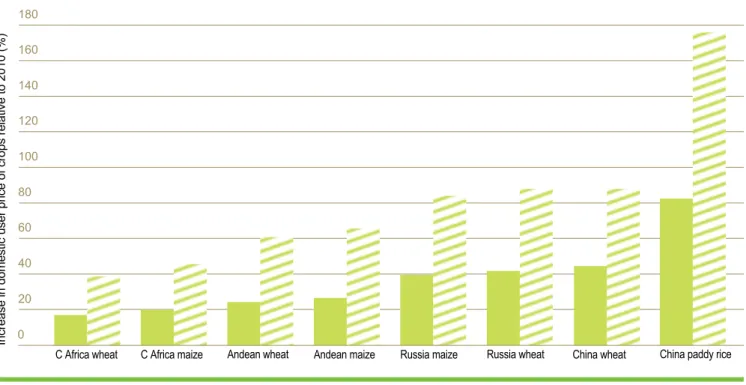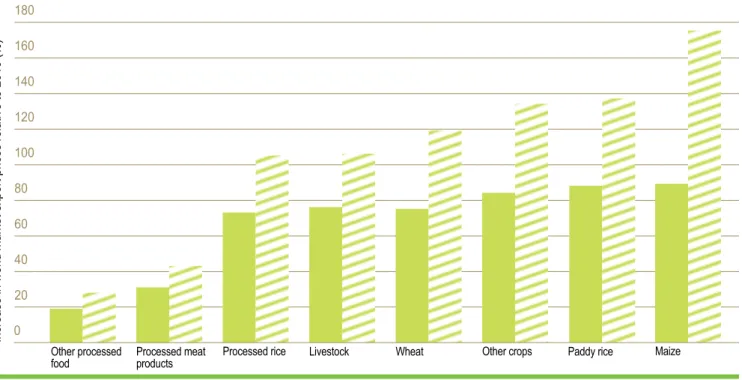Growing a
Better Future
Food justice in a resource-constrained world
www.oxfam.org/grow
Author: Robert Bailey Acknowledgements
This report was written by Robert Bailey and coordinated by Gonzalo Fanjul. Its development was a co-operative effort, involving Oxfam staff and partner organisations.
It draws on the findings of a research programme managed by Richard King, Javier Pérez and Kelly Gilbride. Alex Evans, Javier García, Silvia Gómez, Duncan Green, Kirsty Hughes, Richard King, Kate Raworth, Jodie Thorpe, Kevin Watkins and Dirk Willenbockel made specific written contributions to the report, which also draws on an extensive list of case studies, notes and background research that can be found at www.oxfam.org/grow
Many colleagues contributed with extensive comments and inputs to the drafts of the report. Special mention should be made of Nathalie Beghin, Sarah Best, Phil Bloomer, Stephanie Burgos, Tracy Carty, Teresa Cavero, Hugh Cole, Mark Fried, Stephen Hale, Paul Hilder, Katia Maia, Duncan Pruett, Anna Mitchell, Bernice Romero, Ines Smyth, Alexandra Spieldoch, Shawna Wakefield, Marc Wegerif and Bertram Zagema.
Production of the report was managed by Anna Coryndon. The text was edited by Mark Fried.
© Oxfam International June 2011
This report and information about the Grow Campaign are available at www.oxfam.org/grow
This publication is copyright but text may be used free of charge for the purposes of advocacy, campaigning, education, and research, provided that the source is acknowledged in full. The copyright holder requests that all such use be registered with them for impact assessment purposes. For copying in any other circumstances, or for re-use in other publications, or for translation or adaptation, permission must be secured and a fee may be charged. E-mail publish@oxfam.org.uk.
Published by Oxfam GB for Oxfam International under
ISBN 978-1-84814-852-9 in June 2011. Oxfam GB, Oxfam House, John Smith Drive, Cowley, Oxford, OX4 2JY, UK. Oxfam GB is registered as a charity in England and Wales (no. 202918) and in Scotland (SCO 039042) and is a member of Oxfam International.
Oxfam is an international confederation of fifteen organizations working together in 98 countries to find lasting solutions to poverty and injustice:
Oxfam America (www.oxfamamerica.org), Oxfam Australia (www.oxfam.org.au), Oxfam-in-Belgium (www.oxfamsol.be), Oxfam Canada (www.oxfam.ca), Oxfam France (www.oxfamfrance.org), Oxfam Germany (www.oxfam.de), Oxfam GB (www.oxfam.org.uk),
Oxfam Hong Kong (www.oxfam.org.hk), Oxfam India (www.oxfamindia.org)
Intermón Oxfam (www.intermonoxfam.org), Oxfam Ireland (www.oxfamireland.org), Oxfam Mexico (www.oxfammexico.org), Oxfam New Zealand (www.oxfam.org.nz), Oxfam Novib (www.oxfamnovib.nl), Oxfam Quebec (www.oxfam.qc.ca) The following organizations are currently observer members of Oxfam International, working towards full affiliation:
Oxfam Japan (www.oxfam.jp) Oxfam Italy (www.oxfamitalia.org)
Please write to any of the agencies for further information, or visit www.oxfam.org.
For further information on the issues raised in this report, please e-mail: advocacy@oxfaminternational.org
www.oxfam.org/grow
Growing a
Better Future
Food justice in a resource-constrained world
Contents
ii Acknowledgements 03 List of figures 05 1 Introduction 11 2 The Age of Crisis:
a skewed and failing system 12 2.1 A failing food system
14 2.2 The sustainable production challenge 15 Yield increases drying up
16 Policy making captured by the few 17 Natural resources squeezed 19 Climate changing
21 Demography, scarcity and climate change:
a perfect storm scenario for more hunger 29 Meeting the sustainable production challenge 30 2.3 The equity challenge
32 Access to land
33 Women’s access to land 34 Access to markets 35 Access to technology 35 Claiming rights
36 2.4 The resilience challenge 36 Increasing fragility
38 Food prices gone wild 38 Climate chaos 39 Government failures
39 A humanitarian system at breaking point 40 National level action
41 Time to rebuild
43 3 The new prosperity 44 3.1 Growing a better future
46 3.2 A new governance for food crises 46 International reform
48 National approaches 50 A new global governance 52 3.3 A new agricultural future 54 Four myths about smallholders 56 A new agricultural investment agenda 58 3.4 Building the new ecological future 58 Equitable distribution of scarce resources 59 An equitable transition
62 3.5 The first steps: Oxfam’s agenda 65 4 Conclusion
68 Notes 72 Images
List of figures
12 Figure 1: Real food price changes predicted over the next 20 years
13 Figure 2: The challenge of increasing equity within ecological limits
15 Figure 3: The ecological footprint of food 17 Figure 4: The share of land devoted to
agriculture has peaked
18 Figure 5: The land grab legacy of the 2008 food price crisis
21 Figure 6: The proportion of household expenditure allocated to food, with predictions to 2030
22 Figure 7: Predicted increases in world food commodity prices
23 Figure 8: Comparative growth rates in population and crop productivity: maize in sub-Saharan Africa and rice in Asia
24 Figure 9: Predicted food price increases for domestic users to 2030
25 Figure 10: Predicted impact of climate change on world market food export prices to 2030
26 Figure 11: The predicted impact of climate change on maize productivity to 2030
26 Figure 12: The predicted impact of climate change on regional staple food production to 2030
26 Figure 13: The predicted increase in numbers of malnourished children in sub-Saharan Africa in the context of climate change
27 Figure 14: Predicted dampening impacts of climate change adaptation on the price of maize 30 Figure 15: The food system is riddled with inequity 31 Figure 16: The number of hungry people worldwide 32 Figure 17: Where are the hungry people?
34 Figure 18: Who controls the food system?
36 Figure 19: The increasing volatility of food prices 38 Figure 20: Food prices and oil prices are linked 50 Figure 21: Who are the food superpowers?
55 Figure 22: Investment in agricultural R&D ignores Africa
56 Figure 23: Who is investing in agriculture?
60 Figure 24: Governments are good at investing in public bads
Chapter 1: Introduction
Introduction 1
Niger is the epicentre of hunger. Here, it is chronic.
Corrosive. Structural. Systemic. Over 65 per cent of people survive on less than $1.25 a day.1 Nearly one in two children is malnourished.2 One in six dies before they reach the age of five.3
Families are fighting a losing battle against soil depletion, desertification, water scarcity, and unpredictable
weather. They are exploited by a tiny elite of powerful traders who set food prices at predatory levels.
Shocks rain down upon them like hammer blows: a compounding series of disasters, each one leaving them more vulnerable to the next. The drought of 2005. The food price crisis of 2008. The drought of 2010. These events stole lives, shattered families, and obliterated livelihoods. The consequences will be felt for generations.
Chronic and persistent hunger. Rising demand on top of a collapsing resource base. Extreme vulnerability.
Climate chaos. Spiralling food prices. Markets rigged against the many in favour of the few. It would be easy to dismiss Niger, but these problems are not unique – they are systemic. The global food system is broken. Niger is simply on the front line of an impending collapse.
At the start of 2011, there were 925 million hungry people worldwide.4 By the end of the year, extreme weather and rising food prices may have driven the total back to one billion, where it last peaked in 2008. Why, in a world that produces more than enough food to feed everybody, do so many – one in seven of us – go hungry?
The list of answers routinely given is bafflingly long, often crude and nearly always polarized. Too much international trade. Too little international trade. The commercialization of agriculture. A dangerously romantic obsession with peasant agriculture. Not enough investment in techno-fixes like biotechnology.
Runaway population growth.
Most are self-serving, designed to blame the victims or to defend the status quo and the special interests that profit from it. This is symptomatic of a deeper truth:
power above all determines who eats and who does not.
Hunger, along with obesity, obscene waste, and appalling environmental degradation, is a by-product of our broken food system. A system constructed by and on behalf of a tiny minority – its primary purpose to deliver profit for them. Bloated rich-country farm lobbies, hooked on handouts that tip the terms of trade against farmers in the developing world and force rich-country consumers to pay more in tax and more for food. Self- serving elites who amass resources at the expense of impoverished rural populations. Powerful investors who play commodities markets like casinos, for whom food is just another financial asset – like stocks and shares or mortgage-backed securities. Enormous agribusiness companies hidden from public view that function as global oligopolies, governing value chains, ruling markets, accountable to no one. The list goes on.
An age of crisis
2008 marked the start of the new era of crisis. Lehman Brothers collapsed, oil reached $147 a barrel, and food prices leapt, precipitating protests in 61 countries, with riots or violent protests in 23.5 By 2009, the number of hungry people passed one billion for the first time.6 Rich-country governments responded with hypocrisy, professing alarm while continuing to throw billions of dollars of taxpayers’ money at their bloated biofuel industries, diverting food from mouths to petrol tanks.
In a vacuum of trust, governments one after another imposed export bans, pushing up prices further.
Meanwhile the profits of global agribusiness companies rocketed, the returns of speculators soared, and a new wave of land-grabbing kicked off in the developing world, as private and state investors sought to cash in or to secure supply.
Now, as climate chaos sends us stumbling into our second food price crisis in three years, little has changed to suggest that the global system will manage any better this time around. Power remains concentrated in the hands of a self-interested few.
The paralysis imposed upon us by a powerful minority risks catastrophe. Atmospheric concentrations of greenhouse gases are already above sustainable levels and continue to rise alarmingly. Land is running out.
Fresh water is drying up. We have pushed ourselves into the ‘Anthropocene Epoch’ – the geological era in which human activity is the main driver of planetary change.
Our bloated food system is a major cause of this crunch.
But it is also rapidly becoming a casualty. As resource pressures mount and climate change gathers pace, poor and vulnerable people will suffer first – from extreme weather, from spiralling food prices, from the scramble for land and water. But they won’t be the last.
New research commissioned for this report paints a grim picture of what a future of worsening climate change and increasing resource scarcity holds for hunger. It predicts international price rises of key staples in the region of 120 to 180 per cent by 2030. This will prove disastrous for food importing poor countries, and raises the
prospect of a wholesale reversal in human development.
‘We lack food. We’re facing hunger, but we can’t buy much. ... This year things are much worse than before.
Worse than in 2005 when things were bad. Then not everybody faced hunger ... just some areas. But now, everyone
is facing hunger.’
Kima Kidbouli, 60 years, Niger, 2010.
Opposite: Families in Flinigue, Niger receive food vouchers from Oxfam. The vouchers give them the freedom to choose what they buy in a specified store.
(August 2010)
Right: Kimba Kidbouli, 60 years, Niger.
A new prosperity
This future is not certain. Crisis on the scale we are experiencing today almost always leads to change: the Great Depression and the Second World War led to a new world order, the United Nations, the Bretton Woods system, and the spread of welfare states. The oil and economic crises of the 1970s replaced Keynesianism with laissez-faire economics and the Washington Consensus.
The challenge before us today is to seize the opportunity for change and set course towards a new prosperity, an age of co-operation rather than competition, in which the well-being of the many is put before the interests of the few. During the last food price crisis, politicians tinkered at the margins of global governance. This time they must deal with the root causes. Three big shifts are needed:
• First, we must build a new global governance to avert food crises. Governments’ top priority must be to tackle hunger and reduce vulnerability – creating jobs and investing in climate adaptation, disaster risk reduction, and social protection. International governance – of trade, food aid, financial markets, and climate finance – must be transformed to reduce the risks of future shocks and respond more effectively when they occur.
• Second, we must build a new agricultural future by prioritising the needs of small-scale food producers in developing countries – where the major gains in productivity, sustainable intensification, poverty reduction and resilience can be achieved.
Governments and businesses must adopt policies and practices that guarantee farmers’ access to natural resources, technology and markets. And we must reverse the current gross misallocation of resources which sees the vast majority of public money for agriculture flow to agro-industrial farms in the North.
• Finally, we must build the architecture of a new ecological future, mobilizing investment and shifting the behaviours of businesses and consumers, while crafting global agreements for the equitable distribution of scarce resources. A global deal on climate change will be the litmus test of success.
All of this will require overcoming the vested interests that stand to lose out. There is growing appetite to do so as these issues rise up the political agenda, pushed by events and by campaigners, or grasped by leaders with a sense of moral purpose. Though the banks fight reform tooth and nail, public outrage has seen legislative measures passed in the USA, and steps toward regulation in the UK and elsewhere. And a financial transactions tax is on the agenda in the EU and at the G20, alongside measures to rein in commodity speculation and reform agricultural trade. Though special interests continue to pervert food aid in many rich countries, a concerted public campaign in Canada succeeded in freeing it to work effectively; Canada now leads international negotiations to achieve the same outcome globally. Though agricultural subsidies remain enormous, some reform has reduced their negative impacts in developing countries. Though dirty industry continues to block progress on climate change, responsible companies have broken ranks with them.7 A growing number of countries are adopting bold greenhouse gas reduction targets or making ambitious investments in clean technologies. Global investments in renewable technologies overtook fossil fuel spending for the first time in 2009.8
But what is needed is a step change. Strong political leaders with unambiguous mandates from their peoples.
Progressive businesses that choose to break ranks with laggards and blockers. Customers that demand they do so. And it is needed now. The window of opportunity may be short-lived, and many of the choices that must be taken are already upon us: if catastrophic climate change is to be avoided, global emissions must peak within the next four years;9 if we are to avoid a spiralling food price crisis, fragility in the global system must be addressed today.
‘We need to address the question of global hunger not as one of production only, but also as one of marginalization, deepening inequalities, and social injustice. We live in a world in which we produce more food than ever before, and in which the hungry have never been as many.’
Olivier de Schutter, Special Rapporteur on the Right to Food at the FAO Conference, November 2009
Opposite: Women from Dola village construct a pond to irrigate their vegetable gardens. Nepal’s hill districts have lacked investment in agriculture and are faced with a rise in food prices and reduced crop yields as a result of climate change. (Nepal 2010)
Oxfam’s vision
Oxfam has been responding to food crises for nearly 70 years – from Greece in 1942 to Biafra in 1969, Ethiopia in 1984, and Niger in 2005, plus countless other silent disasters that play out beyond the gaze of global media.
All have been entirely avoidable – the result of disastrous decisions, abused power, and perverted politics. More recently, Oxfam has found itself responding to growing numbers of climate-related disasters.
Prevention is better than cure, and so Oxfam also campaigns against the vested interests and unfair rules that corrupt the food system: rigged trade rules, pork- barrel biofuel policies, broken aid promises, corporate power, and inaction on climate change.
Many other organizations – global civil society, producers’ organizations, women’s networks, food movements, trade unions, responsible businesses and empowered consumers, grassroots campaigns for low carbon living, food sovereignty or the right to food – are promoting positive initiatives to alter the way we produce, consume and think about food. Together we will build a growing global movement for change. Together we will challenge the current order and set a path towards a new prosperity.
Chapter 2: The age of crisis:
a skewed and failing system
The age of 2 crisis:
a skewed and
failing system
2.1
A failing food system
The food system is buckling under intense pressure from climate change, ecological degradation, population growth, rising energy prices, rising demand for meat and dairy products, and competition for land from biofuels, industry, and urbanization.
The warning signs are clear. Surging and unstable international food prices, growing conflicts over water, the increased exposure of vulnerable populations to drought and floods are all symptoms of a crisis that may soon become permanent: food prices are forecast to increase by something in the range of 70 to 90 per cent by 2030 before the effects of climate change, which will roughly the double price rises again (see Figure 1).
0 20 40 60 80 100 120
Figure 1: Real food price changes predicted over the next 20 years
Increase in world market export prices relative to 2010 (%)
Other processed
food Processed meat
products Processed rice Livestock Wheat Other crops Paddy rice Maize
140 160 180
2030 climate change 2030 baseline
Source: D. Willenbockel (2011) ‘Exploring Food Price Scenarios Towards 2030’, Oxfam and IDS
We face the unprecedented challenge of pursuing human development and ensuring food for all, in ways that will both keep the planet within essential ecological boundaries and end extreme poverty and inequalities.
Figure 2 illustrates the task at hand.
Even as global population significantly expands, we must:
• Reduce the impacts of consumption to within sustainable limits, and
• Redistribute consumption towards the poorest.
Achieving the vision for 2050 requires a redistribution of power from the few to the many – from a handful of companies and political elites to the billions of people who actually produce and consume the world’s food.
A share of consumption must shift towards those living in poverty, so everyone has access to adequate, nourishing food. A share of production must shift from polluting industrial farms to smaller, more sustainable farms, along with the subsidies that prop up the former and undermine the latter. The vice-like hold over
governments of companies that profit from
environmental degradation – the peddlers and pushers of oil and coal – must be broken.
There are three major challenges that must be met:
• The sustainable production challenge: we must produce enough nourishing food for nine billion people by 2050 while remaining within planetary boundaries;
• The equity challenge: we must empower women and men living in poverty to grow or to buy enough food to eat;
• The resilience challenge: we must manage volatility in food prices and reduce vulnerability to climate change.
Running through each are fault lines along which struggles for power and resources will play out. This chapter sets out each in detail.
Figure 2: The challenge of increasing equity within ecological limits
Population:
7bn
Planetary boundaries Ecological impact of global resource use Resource share of the worst-off 20% of people Population:
9bn
2010 2050
2.2
The sustainable production challenge
Agriculture faces a daunting challenge. It must
dramatically increase food production while completely transforming the way in which food is produced. On current trends, demand for food may increase by 70 per cent by 205010 due to population growth and economic development. The Earth’s population is expected to grow from around 6.9 billion today to 9.1 billion in 2050 – an increase of one-third11 – by which time an estimated seven out of ten people worldwide will live in Low-Income Food Deficit Countries (LIFDCs).12
These are forecasts with big margins of error.
Greater investment in solutions that increase women’s empowerment and security – by improving access to education and healthcare in particular – will slow population growth and achieve stabilization at a lower level.
But the Malthusian instinct to blame resource pressures on growing numbers of poor people misses the point, because people living in poverty contribute little to world demand. Skewed power relations and unequal
consumption patterns are the real problem.
The global economy is forecast to be three times bigger by 2050, with emerging economies’ share of output rising from one-fifth to well over a half.13 This is a good thing, and fundamental to addressing the challenges of equity and resilience. But for this level of development to be viable, an unprecedented shift to more sustainable consumption trends must take place in both industrialized and emerging economies.
Right: Charles Kenani standing in his rice field. The Oxfam-funded Mnembo Irrigation scheme has helped 400 families in Malawi by transforming their traditional small low-yield crops into year-round, high volume harvests that provide continuous food and a source of income. (Malawi, 2009)
‘We started this irrigation scheme
because we were facing problems with the climate. ... It’s impossible to harvest enough for the whole year when you have to rely on the rain. Now we have access to water during the dry months we are able to plant several crops in a year – wheat, rice and tomatoes.
We no longer see the problems other people face.’
Charles Kenani, farmer, Malawi
At present, higher incomes and increasing urbanization leads people to eat less grains and more meat, dairy, fish, fruit, and vegetables. Such a ‘Western’ diet uses far more scarce resources: land, water, atmospheric space (see Figure 3).
In the meantime, in more than half of industrialized countries, 50 per cent or more of the population is overweight,14 and the amount of food wasted by consumers is enormous – quite possibly as much 25 per cent.15
Yield increases drying up
In the past, rising demand has been met and surpassed by increasing crop yields, but the dramatic achievements of the past century are running out of steam. Global aggregate growth in yields averaged 2 per cent per year between 1970 and 1990, but plummeted to just over 1 per cent between 1990 and 2007. This decline is projected to continue over the next decade to a fraction of one per cent.16
The US Department of Agriculture’s Economic Research Service observed in 2008 that global consumption of grain and oilseeds outstripped production for seven of the eight years between 2001 and 2008.17
Modern agro-industrial farming is running faster and faster just to stand still. Put simply, increasing irrigation and fertilizer use can only get us so far, and we’re nearly there. With the exception of parts the developing world, the scope for increasing the area under irrigation is disappearing.18 Increasing fertilizer use offers ever diminishing returns and serious environmental consequences.
But it is not like this everywhere. Throughout the developing world, there is huge untapped potential for yield growth in small-scale agriculture.19 With the right kind of investment this potential can be realised – helping to meet the sustainable production challenge while delivering agricultural development for people in poverty.
Figure 3: The ecological footprint of food
Water footprint (litres)i
iAssumes an average egg weighs 60g, and the density of milk is 1kg per litre.
iiBased on production in England and Wales
iiiBased on production in England and Wales, assumes all production is on land of an equal grade
Sources: Water http://www.waterfootprint.org/?page=files/productgallery; emissions and land use UK DEFRA (2006),
http://goo.gl/T12ho; grain National Geographic, http://goo.gl/4CgFB; calories USDA National Nutrient Database, http://goo.gl/7egTT Calories (Kcal) Grain (for feed) (kg)
Land use (m2)iii Emissions (Kg CO2e)ii
MILK
RICE
15,500
16 7.9 6 2470
1650 1430 610 3400 1300
3,900
4.6 6.4 1.8
3,333
5.5
1,000
10.6 9.8
1,300
0.8 1.5
3,400
6.7
1 Kg BEEF
CHICKEN
EGGS
WHEAT
Policy making captured by the few
Sadly, investment in developing country agriculture, despite the huge potential benefits, has been pitiful.
Between 1983 and 2006, the share of agriculture in official development assistance (ODA) fell from 20.4 per cent to 3.7 per cent, representing an absolute decline of 77 per cent in real terms.20 During this time rich country governments did not neglect their own agricultural sectors. Annual support spiralled to over
$250bn a year21 – 79 times agricultural aid22 – making it impossible for farmers in poor countries to compete.
Confronted with these odds, many developing country governments chose not to invest in agriculture, further compounding the trend.
The costs of rich country support are borne not only by poor farmers in the developing world, but also by people in rich countries, who pay twice – first through higher tax bills, and second through higher food prices. It is estimated that in 2009, the EU’s Common Agricultural Policy (CAP) added €79.5bn to tax bills and another
€36.2bn to food bills.23 According to one calculation, it costs a typical European family of four almost €1,000 a year. The real irony is that the CAP purports to help Europe’s small farmers, but it is the rich few that benefit the most, with about 80 per cent of direct income support going into the pockets of the wealthiest 20 per cent – mainly big landowners and agribusiness companies.24 Never, in the field of farming, has so much, been taken from so many, by so few.
In the aftermath of the 2008 food price crisis, rich countries at the G8 Summit announced the l’Aquila Food Security Initiative: a commitment to mobilize $20bn over three years for investment in developing countries. If this was an attempt to atone for past sins, it was, at best, underwhelming. The pledge amounted to a derisory fraction of the subsidies that rich countries were lavishing on their biofuels industries at the time – one of the key drivers of the 2008 price hike.25 Incredibly, a large portion of this figure has turned out to be recycled from past promises or double-counted against other commitments.
In the case of Italy, the l’Aquila commitment actually represented a reduction in aid.26
Rich country governments have spectacularly failed to resist the capture of agricultural policy making by their farm lobbies. The results? Drastically reduced agricultural productivity and increased poverty in the South, and the plunder of hundreds of billions of dollars a year from taxpayers in the North.
Natural resources squeezed
The huge increase in demand for food must be met from a rapidly depleting resource base, squeezed by biofuel production, carbon sequestration and forest conservation, timber production, and non-food crops.
As a result, the share of land devoted to food production has peaked (see Figure 4).
At the same time, the amount of arable land per head is decreasing, having almost halved since 1960.27 Nobody really knows how much land remains, but it isn’t much.28 Very often, land that may be termed idle or marginal in fact plays a critical role in the livelihoods of marginalized people such as pastoralists, indigenous peoples and women.
Increase in demand is not likely to be met by the expansion of production area. Nevertheless, whatever land there is will surely be prized. The vast majority looks to be in sub-Saharan Africa and Latin America.29
Water, the lifeblood of agriculture, is already scarcer than land. Nearly three billion people live in areas where demand outstrips supply.30 In 2000, half a billion people lived in countries chronically short of water; by 2050 the number will have risen to more than four billion.31 By 2030, demand for water is expected to have increased by 30 per cent.32
Agriculture accounts for 70 per cent of global fresh water use,33 and is both a driver and increasingly a victim of water scarcity. Climate change will only exacerbate an already acute problem, particularly in already stressed regions. Shrinking glaciers will reduce flows in crucial rivers – for example, the Ganges, Yellow, Indus, and Mekong Rivers all depend on the Himalayas. Rises in sea level will salinate fresh water, while floods will contaminate clean water.
Figure 4: The share of land devoted to agriculture has peaked
33 38
37
36
35
34
0.6 1.6
1.4
1.2
1.0
0.8 Agricultural area (hectares per capita)
Agricultural area (% of global land area)
Source: Calculated from FAO, http://faostat.fao.org/site/377/default.aspx
1961 1964 1968 1972 1976 1980 1984 1988 1992 1996 2000 2004 2008
% of global land area hectares per capita
‘For with the land comes the right to withdraw the water linked to it, in most countries essentially a freebie that increasingly could be the most valuable part of the deal.’
Peter Brabeck-Lethmath, CEO, Nestlé
Opposite: Rice prices in Cambodia soared in 2008. The pile of rice on the left was bought in 2008, and the pile on the right shows what the same money would have bought in 2007. (Cambodia, 2008)
The Middle East offers a taste of what may be to come.
Aquifers are rapidly becoming exhausted and the area under irrigation is in decline. Saudi Arabia has
experienced precipitous falls of over two-thirds in wheat production since 2007, and on current trends will become entirely dependent on imports by next year.34 Middle Eastern states are among the biggest land investors in Africa,35 driven not by a lack of land but a lack of water.
Many governments and elites in developing countries are offering up large swathes of land amid clouds of corruption at rock bottom prices. Companies and investors are cashing in, while food-insecure governments are rushing to secure supply. The scramble began with the 2008 food price crisis, and continues unabated: in 2009, Africa saw 22 years’
worth of land investment in 12 months (see Figure 5).36
Research from the International Land Coalition, Oxfam Novib and partners identifies over 1,200 land deals reportedly under negotiation or completed, covering 80m hectares,37 since 2000 – the vast majority of them after 2007. Over 60 per cent of the land targeted was in Africa.38
Of course, investment can be a good thing. But price rises like the one we saw in 2008 spark a frenzy among investors, with many acting speculatively or in fear of losing out. And why not? The land is usually dirt cheap, apparently idle and, anyway, investing in land is a one-way bet these days: the price will only go up as it becomes more and more scarce. Investors have been acquiring land in much larger quantities than they could possibly use, leading the World Bank to wonder if the purpose is to lock in the highly favourable terms currently on offer and avoid future competition.39 The most
comprehensive research to date suggests that 80 per cent of projects reported in the media are undeveloped, and only 20 per cent had begun actual farming.40
Jan 2002 Jan 2003 Jan 2004 Jan 2005 Jan 2006 Jan 2007 Jan 2008 Jan 2009 Jan 2010
Figure 5: The land grab legacy of the 2008 food price crisis
50 100
0 150 200 250
Number of monthly media stories on land grabs FAO Food Price Index (2002–2004 = 100)
Sources: FAO http://www.fao.org/worldfoodsituation/wfs-home/foodpricesindex/en/ and http://www.factiva.com
Box 1: A new breed of land investor
Where there is scarcity, there is opportunity. And financial investors are quick to turn opportunity into profit. Numerous hedge funds, private equity funds, sovereign wealth funds and institutional investors are now buying up farmland in developing countries. One is Emergent Asset Management, currently enjoying the arbitrage opportunity presented by ‘very, very inexpensive’ land values in sub-Saharan Africa.41 Emergent points out that Zambian land, though some of the most expensive in sub-Saharan Africa, is still one-eighth the price of similar land in Argentina or Brazil, and less than a twentieth of that in Germany.
Emergent assumes that land will generate strong returns as prices rise – in part because of increasing demand for land from the food powers of Brazil and China.42
One of Emergent’s stated strategies is to identify poorly managed or failing farms and buy them up at distressed prices, then turn them around in order to boost returns. Rapidly appreciating land prices provide a ‘backstop’ should this risky strategy fail.
Agricultural investment is desperately needed. And Emergent argues that it is not simply building up land banks – it also invests to increase productivity and brings in new techniques and technologies, as well as making ‘social investments’ in schools, hospitals and housing. But the risk remains that some investors will be interested only in the easy return on land, rather than the trickier business of growing food.
Climate changing
Climate change poses a grave threat to food production.
First, it will apply a further brake on yield growth.
Estimates suggest that rice yields may decline by 10 per cent for each 1°C rise in dry-growing-season minimum temperatures.43 Modelling has found that countries in sub-Saharan Africa could experience catastrophic declines in yield of 20–30 per cent by 2080, rising as high as 50 per cent in Sudan and Senegal.44
Second, it will increase the frequency and severity of extreme weather events such as heatwaves, droughts and floods which can wipe out harvests at a stroke.
Meanwhile, creeping, insidious changes in the seasons, such as longer, hotter dry periods, shorter growing seasons, and unpredictable rainfall patterns are bewildering poor farmers, making it harder and harder for them to know when best to sow, cultivate, and harvest their crops.45
For people without the incomes, savings, access to healthcare or social insurance enjoyed in industrialized countries, shocks from climatic disasters or shifting seasons often force them to go without food, sell off assets critical to their livelihoods, or take their children out of school. Short-term coping strategies can have long-term consequences, causing a downward spiral of deeper poverty and greater vulnerability.
Despite the scale and urgency of the challenge, governments have failed to take adequate action to reduce emissions, collectively or individually. Instead they have listened to their industrial lobbies – the small number of companies that stand to lose from a transition towards a sustainable future from which the rest of us would gain (see Box 2).
Box 2: Dirty industry and grubby lobbying
Lobbying from dirty industries has kept Europe locked into low ambition on reducing its greenhouse gas emissions, marginalizing its influence in negotiations and preventing a transition to a low-carbon economy.
Others, meanwhile, race past – most notably China, now the world’s biggest sovereign investor in renewables.46 Some of the most intense lobbying comes from steel, oil and gas, chemicals, and paper companies and the associations that speak on their behalf,47 as well as from wider cross-sectoral umbrella groups, most depressingly of all BusinessEurope – the general European employers’ association – to which most major companies that profess deep concern about climate change belong. These faceless associations have low public profiles, allowing
supposedly ‘responsible’ companies to keep their hands clean.
Companies not only lobby against greater climate ambition, they also lobby to capture regulation for themselves. For example, ArcelorMittal, the world’s largest privately owned steel company, has lobbied to secure free allowances under the EU Emissions Trading Scheme (ETS). The company has profited nicely from its lobbying, ending up with allowances to spare – potentially allowing it to increase its emissions in the future. All these surplus allowances depress the carbon price and remove the incentives for investment in clean technologies that the carbon market was designed to provide. By 2012 ArcelorMittal could potentially make over €1bn from these free handouts,48 turning on its head the principle at the heart of the ETS – that the polluter pays.
Climate change not only threatens agriculture, the way we now farm also threatens the climate. While not the only contributor to greenhouse gas emissions, nor even the greatest, agriculture accounts for a significant share of the damage: somewhere between 17 and 32 per cent of all human-induced greenhouse gases.49 Key drivers are emissions from fertilizer use and from cattle.50 Alarmingly, both are set to increase significantly.51 The biggest contributor by far to agricultural emissions, however, is land-use change;52 converting wilderness to agriculture can release large amounts of greenhouse gases, particularly in the case of forests and wetlands.
(See Box 3)
Box 3: Palm oil – eating the world’s forests
The oil palm is a remarkable crop. It is high-yielding and fast-growing. Its oil provides a versatile ingredient used throughout the world, though few of us realize it. Palm oil can be found in chocolate, bakery products, sauces, chips, margarine, cream cheese, sweets, and ready meals. It is produced mainly by major plantation companies in Malaysia and Indonesia, and bought in vast quantities by food manufacturers such as Unilever, Kraft, and Nestlé.
Our hunger for palm oil appears insatiable. Demand is expected to double from 2000 to 2050.53 This holds terrifying implications for the rainforests of Indonesia, where every minute plantations eat one more hectare further into one of the planet’s most carbon-rich major ecosystems.54
About 80 per cent of palm oil ends up in food,55 but a growing amount is used for biodiesel. Regulations in the EU, USA and Canada that require minimum biofuels content in gasoline and diesel are further driving deforestation either directly or because palm oil is replacing other edible oils diverted for biodiesel use.
Oxfam estimates that even if the EU excludes all biodiesel produced from deforested land, its mandate could raise emissions from deforestation by up to 4.6bn tonnes of CO2 – nearly 70 times the annual CO2 saving the EU expects to make by reaching its target to derive 10 per cent of its transport energy from biofuels by 2020.56
‘... nowadays when it comes to the rains sometimes you get too much and it
destroys the crops. Sometimes you don’t get any at all and the crops just wilt. If that happens, you don’t have any food the next year. About the rains, I don’t know what we can do.’
Killa Kawalema, farmer, Malawi
Demography, scarcity and climate change: a perfect storm scenario for more hunger
Predicting the future is a hazardous endeavour. When it comes to agricultural production and nutrition, there are many unknowns. Yet detailed scenarios and projections developed for this report point unequivocally towards an overwhelming conclusion: the world faces a real and imminent risk of major setbacks in efforts to combat the scourge of hunger.57 That risk is not a remote future threat. It is emerging today, will intensify over the next decade, and evolve over the 21st century as ecology, demography and climate change interact to create a vicious circle of vulnerability and hunger in some of the world’s poorest countries.
There are alternatives. But the central message to emerge from the scenario analysis is that the international community is sleepwalking into an unprecedented and avoidable human development reversal. Research carried out for this report explored a range of food price scenarios for 2020 and 2030 using international trade models.58 In the absence of urgent and aggressive action to tackle global warming, prices of basic staple foods are expected to skyrocket in the coming two decades. Using a different model that nevertheless forecasts a similar trend, the International Food Policy Research Institute (IFPRI) has recently calculated that 12 million more children would be consigned to hunger by 2050, compared with a scenario with no climate change.59
Headline figures such as this provide only a partial picture of the scale of threat. Over the lifetime of a single generation, the world is losing an opportunity to remove the spectre of hunger from an under-five population larger than all of the children in that age group living today in France, Germany and the United Kingdom combined. Standing by and failing to prevent that outcome would represent an abdication of responsibility and failure of international leadership without precedent;
not least because this is an avoidable tragedy if – and only if – governments act decisively in the next few years to avert it.
Why the focus on food prices? First, because world food prices provide a useful barometer of how the tectonic shifts in demography, ecology and climate might play out within the food system. Rising prices signal imbalances in the supply response to rising demand. Second, food prices have a major bearing on hunger because they influence the capacity of poor people – and poor countries – to gain access to calories. Of course, prices cannot be viewed in isolation: purchasing power is also influenced by income. But in many of the developing regions facing the gravest challenges with malnutrition, food still accounts for around half of average household spending – and for an even greater share of spending by people living in poverty (see Figure 6).60
‘Exploring Food Price Scenarios Towards 2030’
www.oxfam.org/grow
10 20 30 40 50
Figure 6: The proportion of household expenditure allocated to food, with predictions to 2030
Proportion of household expenditure on food (%)
N America S Asia India W Africa C Africa
60
2020 2030 2004 (baseline)
E Africa 0
International price projections for the major traded food staples reflect the severe stresses under which the food system is buckling. Over the next two decades, prices for commodities such as rice, wheat and maize are forecast to rise by between 60 and 80 per cent (see Figure 7).
This will hit the poorest people the hardest. For example, although food accounts for 46 per cent of an average West African household’s spending, in the poorest 20 per cent of Malian households, food consumes 53 per cent of all household spending; and although in much of South Asia 40 per cent of all household spending goes on food, for the poorest 20 per cent of Sri Lankans, the figure is as high as 64 per cent. 61
Global projections of this type simultaneously obscure and understate scenarios for different regions.
Disaggregated data for four African regions points to a large and sustained divergence between population growth and baseline productivity growth in agriculture.
These are regions with a collective population of over 870 million and some of the world’s highest levels of malnutrition. In West Africa, the population will increase by 2.1 per cent per annum on average, while a simple continuation of past productivity gains would increase maize productivity by 1.4 per cent per annum to 2030 (see Figure 8).
In South and South-East Africa, maize productivity growth is projected to be barely any higher, though population growth is projected to be slower. While the productivity–population growth divergence is less marked in other parts of the world, projections for East Asia (excluding China), India, and the rest of South and Central Asia all point to a future in which agriculture struggles to keep pace with the demands associated with a growing population (see Figure 8b).
10 20 30 40 50 60 70 80 100 90
Figure 7: Predicted increases in world food commodity prices
Increase in world market export prices relative to 2010 (%)
Other processed
food Processed meat
products Processed rice Wheat Livestock Other crops Paddy rice Maize
2030 2020
0
Figure 8a: Comparative growth rates in population and crop productivity:
maize in sub-Saharan Africa
Indexed population and crop productivity growth (2004=100) 100 120 140 160 180 200 220
2004 2005 2006 2007 2008 2009 2010 2011 2012 2013 2014 2015 2016 2017 2018 2019 2020 2021 2022 2023 2024 2025 2026 2027 2028 2029
C and E Africa maize E Africa population
C Africa population W Africa maize
W Africa population South and SE Africa maize
South and SE Africa population
Figure 8b: Comparative growth rates in population and crop productivity: rice in Asia
Indexed population and crop productivity growth (2004=100) 100 110 120 130 140 150 160
C Asia population Other S Asia population
India, Other S Asia, C Asia rice India population
Other E and SE Asia rice Other E and SE Asia population
2004 2005 2006 2007 2008 2009 2010 2011 2012 2013 2014 2015 2016 2017 2018 2019 2020 2021 2022 2023 2024 2025 2026 2027 2028 2029
Regional price projections reflect underlying shifts in supply and demand. Figure 9 provides an insight into the magnitude of food staple price inflation for a number of crops and regions. In Central Africa, consumers of maize face the prospect of a 20 per cent increase in prices over the next decade, with an equivalent increase over the following decade.
In the Andean countries, wheat and maize prices will rise by 25 per cent to 2020; and, in the case of maize, by 65 per cent to 2030.
The bad news is that these are good case scenarios because they do not factor in climate change effects.
Climate change is a potent risk multiplier in agriculture.
Our projections capture the simulated impact of climate change on world prices for the major traded food staples (see Figure 10). In the case of maize, the incremental effect of climate change on price inflation is around 86 per cent. There are also marked effects for rice and wheat. In summary, these expected effects would wipe out any positive impacts from expected increases in household incomes, trapping generations in vicious circle of food insecurity.
Figure 9: Predicted food price increases for domestic users to 2030
2030 2020
0 20 40 60 80 100 120
Increase in domestic user price of crops relative to 2010 (%)
C Africa wheat C Africa maize Andean wheat Andean maize Russia maize Russia wheat China wheat 140
160 180
China paddy rice
Opposite: Rice sellers Sok Nain and Mach Bo Pha in Dem Kor Market in Phnom Penh. Sellers say their profits have fallen by 30 per cent as rice prices in Cambodia soared in 2008. (Cambodia 2008)
Figure 10: Predicted impact of climate change on world market food export prices to 2030
Increase in world market export prices relative to 2010 (%)
Other processed
food Processed meat
products Processed rice Livestock Wheat Other crops Paddy rice
2030 climate change 2030 baseline
Maize 20
40 60 80 100 120 140 160 180
0
The impact of climate change on food prices is clearly closely linked to the impacts that climate change will have on crop production. Here too, our scenarios point towards some disturbing warning signals. Some of the major internationally traded grains included in our model are important food staples for a large group of low- income countries. For example, maize is a major staple across much of sub-Saharan Africa, Central America and the Andean countries. In each case, our scenario points to climate change damaging agricultural productivity (see Figure 11).
Climate change will have adverse effects on aggregate production volumes (Figure 12), as well as agricultural productivity (Figure 11), across all developing regions.
Projections raise particularly worrying concerns for maize production in sub-Saharan Africa. Moreover, the trends captured in our scenarios to 2030 are consistent with long-term trend analysis carried out by IFPRI for a wider set of crops. That analysis points to a marked climate change effect in reducing yields of sweet potatoes and yams, cassava, and wheat by 2050 (respectively 13, 8, and 22 per cent lower than under a scenario without climate change).62
Figure 11: The predicted impact of climate change on maize productivity to 2030
-40 -35 -30 -25 -20 -15 -10 -5
Percentage changes in maize productivity relative to 2030 baseline -45 South and
SE Africa W Africa C Africa E Africa C America Andean
-20 -15 -10 -5
-25
Figure 12: The predicted impact of climate change on regional staple food production to 2030
Percentage changes in domestic output relative to 2030 baseline Brazil
wheat C Africa
maize W Africa
maize E Africa maize
China paddy rice
Other E and SE Asia paddy rice
100 200 300 400 500 600 700 800 1000 900
Figure 13: The predicted increase in numbers of malnourished children in sub-Saharan Africa in the context of climate change
Children, thousands
2010 2030 2050
0
Ultimately, price and production scenarios are only as useful as the insights they provide into the threats facing vulnerable people, and the policy options for
governments seeking to avert those threats. So what picture do our scenarios paint for the state of world hunger in 2050?
The relentless underlying pressure on the world food system and the risk multiplier effects associated with climate change raise the spectre of an early slowdown in the rate at which malnutrition is falling, followed by medium-term reversals in many countries. Inevitably, the affects will be uneven. Middle-income countries with strong economic growth and a diversified export base will be in a position to mitigate the transmission of world price inflation back to domestic markets. However, many low-income and lower middle-income countries are poorly placed to absorb the impact of higher food import prices.
Once again, sub-Saharan Africa faces some of the gravest threats. Higher prices will translate into depressed demand for food in a region that already has the world’s lowest calorific intake. In a world without climate change, sub-Saharan Africa would still face problems in combating the hunger epidemic. Under a simple baseline scenario, child malnutrition levels would increase by around 8 million to 2030 and by 2050 would revert to the same level as at the turn of the 21st century – around 30 million. Adding in the effects of climate change would increase child malnutrition by just under one million (compared with no climate change) in 2030 (see Figure 13).63
It should be emphasized that the scenarios developed by Oxfam’s commissioned research do not define the world’s destiny. They highlight plausible outcomes based on business-as-usual scenarios. Other futures are possible. Strengthening national agricultural policies and reprioritizing agriculture within the international development agenda more generally would help to raise productivity among small-scale food producers, in turn ensuring that regional productivity keeps pace with population growth. Building a new international governance to avert food crises and respond more effectively when they occur will help shield food-insecure countries and households from future shocks.
Unfortunately, inertia in the climate system means action to reduce greenhouse gas emissions today will be unable to significantly mitigate climate change within the timescales modelled here, but it will help prevent climate change having even more devastating impacts further in the future. In the face of unavoidable climate change over the coming decades, decisive action by rich countries to support climate change adaptation in the developing world is an urgent priority and will
considerably ameliorate the level of food price inflation (see Figure 14), preventing millions of additional cases of malnutrition.
20 40 60 80 100 120
10 30 50 70 90 110
Figure 14: Predicted dampening impacts of climate change adaptation on the price of maize
Percentage price increase relative to 2010 baseline (%)
W Africa C Africa E Africa South and SE Africa
Climate change impact Climate change adaptation Baseline
0
Meeting the sustainable production challenge
Increasing production by 70 per cent within 40 years is a massive challenge, but entirely possible. The key is for rich country governments to resist their agricultural lobbies and remove the trade-distorting support measures which stifle investment where the real potential for increasing yields lies: the small farms of the developing world. Such a shift would free up huge budgetary resources, some of which could be redirected towards ODA for agriculture – kick-starting the rural renaissance needed.
Food availability food can also be increased massively by addressing waste – estimated at between 30 and 50 per cent of all food grown.64 In rich countries, where around a quarter of the food purchased by households may be wasted,65 consumers and businesses must change their behaviours and practices. In developing countries, where waste occurs post-harvest due to poor storage and transport infrastructure, governments must increase investment.
Pressures on land and water can be reduced through new practices and techniques that boost yields, use soils and water more sensitively, and reduce their reliance on inputs – techniques such as drip-feed irrigation, water harvesting, low- or zero-till agriculture, agroforestry, intercropping, and the use of organic manures. These would also significantly reduce the carbon footprint of agriculture.
Recent research commissioned by Oxfam simulating the evolution of the costs, income and profits of agroforestry systems in Bolivia demonstrates this.66 These techniques achieved the objectives of forest conservation and climate change mitigation, presenting an alternative to the expansion of the agricultural frontier by soy and cattle farmers through deforestation. Moreover, the income of an average household involved in agroforestry is around five times larger than for any of their immediate
alternatives (such as agriculture, small livestock farming or chestnut collection).
National governments can do much more to manage their scarce resources.
Pricing water for industry and commercial agriculture will force businesses and large farms to improve their efficiency. Removing subsidies that inadvertently encourage profligate water use – such as many provided to electricity generators – is also essential. Governments can invest in water management – a very attractive proposition, as estimates suggest that for every dollar spent, a country can expect eight dollars back in averted costs and increases in productivity.67 And they can regulate investments in land to deliver wider social and environmental objectives: the respect of land rights, and the protection of forests and biodiversity.
Opposite: Noograi Snagsri now spends less time working in her fields thanks to the new integrated farming system where water is piped directly into the fields. In 2007 farmers in Yasothorn Province, north-east Thailand, experienced the longest dry spell in decades.
(Thailand, 2010)
Right: Harvested palm fruit, the raw material for palm oil, used to produce various food stuffs, soap and biofuel.
2.3 The equity challenge
Almost one in seven people worldwide is chronically undernourished. After decades of slow decline, global hunger began to rise in the mid-1990s and soared during the 2008 food price crisis. Had the previous trend of slow progress been maintained, 413 million fewer people would be hungry today.
While the number of hungry people has thankfully dropped back from its 2008 high point of one billion, it remains higher than at any time before the crisis, and may well climb again in 2011 (see Figure 16).
Perhaps counter-intuitively, around 80 percent of hungry people are thought to live in rural areas, where most of them work as small-scale food producers: farmers, herders, fishers, or labourers.68 (See Figure 17) They are surrounded by the means to produce food, and yet they go without.
Figure 15a: The food system is riddled with inequity: emissions and food supply
Sources: FAO, http://faostat.fao.org/site/368/DesktopDefault.aspx?PageID=368 and World Resources Institute, http://cait.wri.org Total GHG Emissions in 2007 (tonnes CO2e per person) Food supply (kcal/capita/day) in 2007
19.3
2 2.5 7.4
0.1 0.1 1.3
1.8 19
11.4
8.7 9.9 3748
3113 2264 2999
2376 1980
3458
3376
2352 3227
2538
2812
Figure 15b: The food system is riddled with inequity: women’s access to land
Numbers represent % agricultural holdings headed by women (1996–2007)
Source: FAO, http://www.fao.org/economic/es-policybriefs/multimedia0/female-land-ownership/en/
20.4 29.9
18.1 3.1
32.1 34.8 2.8 27.4 8.8 25.4
Figure 16: The number of hungry people worldwide
People hungry globally (millions)
700 750 800 850 900 950 1000 1050 1100
Sources: FAO, http://www.fao.org/hunger and Financial Times, http://cachef.ft.com/cms/s/0/68b31de6-392e-11e0-97ca-00144feabdc0,s01=2.html
2011
2007
2003
1999
1995
1991
1987
1983
1979
1975
19711969
1969–71
1979–81
1973 2009200520011997199319811977 1985 1989
1990–2
1995–7
2000–2
2005–7 2008
2009
2010 2011
